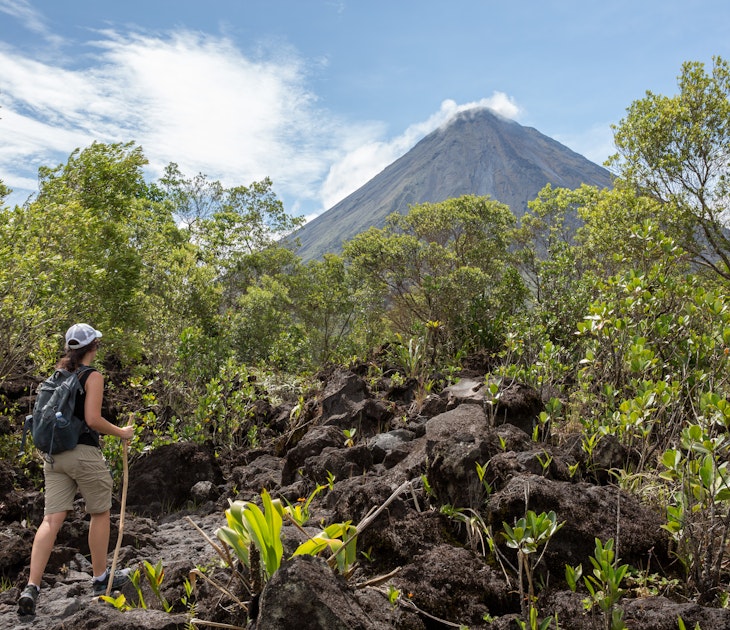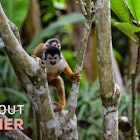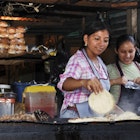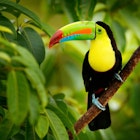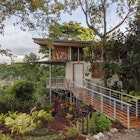Covering some 10% of Costa Rican territory, the country’s national parks protect a stunning array of landscapes – wetlands and forests, caves and volcanoes, and habitats for creatures galore. This is the country’s greatest natural resources, and it’s all yours to discover: summit cloud-shrouded peaks or delve into dense jungles; trek overland or barrel down mountainsides; spot a scarlet macaw or hear a howler monkey. Choose your own adventure, pick a park, and you’re off on a wild ride in Costa Rica.

Hiking
Doing at least some hiking in Costa Rica is practically required, as it’s the only way to experience some of the country’s top attractions. The good news is that you can often see amazing sights on relatively easy day hikes. It doesn’t take long to find fantastic waterfalls at Volcán Arenal National Park, or to marvel at the cerulean blue waters of Río Celeste at Volcán Tenorio National Park. On a half-day hike you can peer into the volcanic crater at Volcán Poás or see bubbling mudpots and fumaroles at Rincón de la Vieja.
With more time and effort, hikers can get higher into the mountains or deeper into the forest. The most popular multi-day trek is through the clouds to the summit of Cerro Chirripó (3820m), Costa Rica’s highest peak, located in the eponymous park. By contrast, hiking across Corcovado National Park gives a glimpse into pristine coastal rainforest – unbeatable for seeing animals in the wild. Both of these treks require a minimum of two days, with an overnight in designated areas, although an extra day is recommended to get the most out of the experience.
Some national parks offer opportunities for even longer-term hiking, especially in Chirripó, Corcovado and even La Amistad International Park, the largest and most remote park in the country. Note that these long-distance trails are generally less trafficked and not well marked, so it’s advisable (and sometimes required) to hire a local guide.

Biking
Perhaps you’d like to move at a quicker pace, experiencing Costa Rica on two wheels. Mountain biking has become increasingly popular in recent years, thanks to the endless challenges of the diverse and rugged terrain. Nothing exemplifies this better than La Ruta de los Conquistadores, considered one of the toughest bike races on the planet. Traversing the country – 161km from Pacific to Caribbean – the three-day stage race takes in multiple national parks, from the tropical rainforest of Carara to the steaming peak of Volcán Irazú. La Ruta was founded, in part, to show off the amazing natural beauty of Costa Rica and to highlight the importance of preserving it. (But truthfully, many participants are too exhausted to enjoy the scenery!)
If you prefer your bike adventure in smaller doses, you can follow a less rigorous mountain biking route. There are bike tour and rental companies in most major tourist towns, though the quality of equipment varies widely. The best trail networks are around Volcán Arenal, Manuel Antonio, Corcovado and Volcán Irazú National Parks.
Horseback riding
When in Costa Rica, do as the Ticos. If this is your philosophy, you’ll want to explore the countryside on horseback, a traditional and revered way of travel. Nowadays, horse farms and tour companies are closely monitored to ensure humane treatment of the horses. Riding tours are available in all main tourist destinations, often traversing national parks, making it a fantastic way to experience the country.
The area around Volcán Arenal National Park is particularly popular for horseback riding, not the least because it is cowboy country, home to expansive cattle ranches and spectacular scenery. Ride for a day or ride for a week, exploring lush forests, mountain slopes and country villages. Ambitious riders can travel the popular tourist route between Monteverde and Arenal on the back of a horse.

Wildlife watching & birdwatching
One of the greatest thrills of spending time in Costa Rica’s national parks is the chance to see fantastic birds, bugs, reptiles and mammals in their natural habitat. You don’t have to go far to catch a glimpse of playful monkeys, sleeping sloths and ostentatious birds flitting about the treetops. Manuel Antonio is the country’s smallest and most popular national park, and it is one of the best places to spot the most common species, including capuchin monkeys, howler monkeys, two- and three-toed sloths, and white-nosed coatis, not to mention the rare Central American squirrel monkey.
The best wildlife watching arguably takes place at Corcovado National Park, and especially at Sirena ranger station. The station’s location in the middle of the park means that it requires a one- or two-day hike to get there (although charter flights are also available). Half of Costa Rica’s animal species live right here in Corcovado. And if you make it to Sirena, you’re likely to spot some good ones, such as all four species of indigenous monkeys, white-lipped and collared peccaries, Baird’s tapirs and northern tamandua, as well as the more common mammals like coatis and sloths. Corcovado also contains the largest population of scarlet macaws, which often make themselves known along the coastal trails.
Birdwatchers flock to national parks to see the country’s most famous species – the scarlet macaw at Carara and the resplendent quetzal at its namesake Los Quetzales National Park. In recent years, the great green macaw has made a comeback thanks to habitat restoration around the (proposed) Maquenque National Park. Wading birds and water birds are the stars of show in the wetlands of Palo Verde, while hundreds of species inhabit the rainforests and cloud forests at national parks throughout the country. If you’re ticking off your bird list, there are 630 indigenous species, plus another couple hundred migratory birds that might be passing through.


